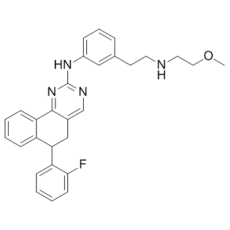This product is for research use only, not for human use. We do not sell to patients.

| Size | Price | Stock |
|---|---|---|
| 100mg | $1550 | Check With Us |
| 250mg | $2250 | Check With Us |
| 500mg | $3375 | Check With Us |
Cat #: V3694 CAS #: 1234356-69-4 (R-enantiomer) Purity ≥ 98%
Description: Derazantinib Racemate is the racemic mixture of derazantinib which is formerly known as ARQ 087 and is a novel, orally bioavailable, ATP competitive, small molecule, multi-kinase inhibitor with potent in vitro and in vivo activity against FGFR (fibroblast growth factor receptor) addicted cell lines and tumors with IC50s of 4.5, 1.8, and 4.5 nM for FGFR1-3 respectively in biochemical assay, IC50 values of 1.8 nM for FGFR2, and 4.5 nM for FGFR1 and 3.
Publications Citing InvivoChem Products
Product Promise

- Physicochemical and Storage Information
- Protocol
- Related Biological Data
- Stock Solution Preparation
- Quality Control Documentation
| Molecular Weight (MW) | 468.58 |
|---|---|
| Molecular Formula | C29H29FN4O |
| CAS No. | 1234356-69-4 (R-enantiomer) |
| Storage | -20℃ for 3 years in powder formr |
| -80℃ for 2 years in solvent | |
| Solubility In Vitro | DMSO: 94 mg/mL (199 mM)r |
| Water: <1mg/mLr | |
| Ethanol: <1mg/mL | |
| SMILES Code | COCCNCCC1=CC(NC2=NC=C3C[C@@H](C4=CC=CC=C4F)C5=CC=CC=C5C3=N2)=CC=C1 |
| Synonyms | ARQ 087; ARQ087; AR-Q087 racemate |
| Protocol | In Vitro | In cells, inhibition of FGFR2 auto-phosphorylation and other proteins downstream in the FGFR pathway (FRS2α, AKT, ERK) is evident by the response to Derazantinib treatment. Cell proliferation studies demonstrate Derazantinib has anti-proliferative activity in cell lines driven by FGFR dysregulation, including amplifications, fusions, and mutations. Cell cycle studies in cell lines with high levels of FGFR2 protein show a positive relationship between Derazantinib induced G1 cell cycle arrest and subsequent induction of apoptosis. |
|---|---|---|
| In Vivo | Derazantinib is effective at inhibiting tumor growth in FGFR2 altered, SNU-16 and NCI-H716, xenograft tumor models with gene amplifications and fusions. |
| Solvent volume to be added | Mass (the weight of a compound) | |||
|---|---|---|---|---|
| Mother liquor concentration | 1mg | 5mg | 10mg | 20mg |
| 1mM | 2.1341 mL | 10.6705 mL | 21.3411 mL | 42.6821 mL |
| 5mM | 0.4268 mL | 2.1341 mL | 4.2682 mL | 8.5364 mL |
| 10mM | 0.2134 mL | 1.0671 mL | 2.1341 mL | 4.2682 mL |
| 20mM | 0.1067 mL | 0.5335 mL | 1.0671 mL | 2.1341 mL |
This equation is commonly abbreviated as: C1 V1 = C2 V2
- (1) Please be sure that the solution is clear before the addition of next solvent. Dissolution methods like vortex, ultrasound or warming and heat may be used to aid dissolving.
- (2) Be sure to add the solvent(s) in order.




































